A Data Assimilation Approach to the Modeling of 3D Hydrodynamic Flow Velocity in River Reaches
Abstract
:1. Introduction
2. Materials and Methods
2.1. TELEMAC System
2.1.1. The TELEMAC-3D Model
2.1.2. The TELAPY Module
2.2. Particle Filter
- (1)
- The Simulation Step
- (2)
- The Updating Step
2.3. Practical Experiment
2.3.1. Study Area
2.3.2. Observations
- 1.
- The water level data
- 2.
- The flow velocity data
2.3.3. TELEMAC-3D Setup
2.3.4. Particle Filter Setup
- (1)
- (2)
- Call the specific function for TELEMAC-3D from FORTRAN API, then load and initialize the TELEMAC-3D configuration with the computed conditions and start the velocity simulation;
- (3)
- Obtain the velocity state variable at each grid node and each time step;
- (4)
- Determine whether there are observations. If no observations exist, continue the simulation process. Otherwise, determine the locations of the HADCP velocity data according to the HADCP installation elevation (the middle layer of the 3D mesh), the grid resolution (the HADCP cell length of 4.4 m), and the coordinates of HADCP;
- (5)
- Generate the N particles of velocity states in each grid node of the HADCP locations by adding the noises generated by the normal distribution N ~ (0, Errm) at time t;
- (6)
- Add the HADCP velocities in U and V directions;
- (7)
- Compute the weight of each particle and perform normalization according to Equations (6) and (7);
- (8)
- To inhibit particle degeneration, use residual resampling to copy high-weight particles and eliminate low-weight particles based on the weights from the previous step. The new particles contain similar weights;
- (9)
- Obtain the assimilated velocity state variables for each grid node of the HADCP locations and set them as the initial velocities at time t + 1;
- (10)
- Repeat Steps (4)–(9) until the end of the simulation period;
- (11)
- Output the assimilated velocities.
2.4. Model Evaluation
2.5. Model Calibration and Validation
3. Results and Discussion
3.1. Preliminary Sensitivity Analysis
3.2. Simulation with Updated Data Assimilation Period
4. Conclusions
Author Contributions
Funding
Data Availability Statement
Conflicts of Interest
References
- Turnipseed, D.P.; Sauer, V.B. Discharge Measurements at Gaging Stations; Techniques and Methods 3-A8; U.S. Geological Survey: Reston, VA, USA, 2010; p. 87. [CrossRef]
- Dobriyal, P.; Badola, R.; Tuboi, C.; Hussain, S.A. A review of methods for monitoring streamflow for sustainable water resource management. Appl. Water Sci. 2016, 7, 2617–2628. [Google Scholar] [CrossRef] [Green Version]
- Boman, B.; Shukla, S. Water Measurement for Agricultural Irrigation and Drainage Systems; Agricultural and Biological Engineering Department, Florida Cooperative Extension Service, University of Florida: Gainesville, FL, USA, 2009. [Google Scholar]
- Chauhan, M.S.; Kumar, V.; Dikshit, P.K.S.; Dwivedi, S.B. Comparison of discharge data using ADCP and current meter. Int. J. Adv. Earth Sci. 2014, 3, 81–86. [Google Scholar]
- Boldt, J.A.; Oberg, K.A. Validation of streamflow measurements made with M9 and River Ray acoustic Doppler current profilers. J. Hydraul. Eng. 2015, 142, 04015054. [Google Scholar] [CrossRef] [Green Version]
- Fulton, J.W. Guidelines for Siting and Operating Surface-Water Velocity Radars; Technical report; USGS: Reston, VA, USA, 2020.
- Creutin, J.D.; Muste, M.; Bradley, A.A.; Kim, S.C.; Kruger, A. River gauging using PIV techniques: A proof of concept experiment in the Iowa River. J. Hydrol. 2003, 277, 182–194. [Google Scholar] [CrossRef]
- Neal, J.; Schumann, G.; Bates, P.; Buytaert, W.; Matgen, P.; Pappenberger, F. A data assimilation approach to discharge estimation from space. Hydrol. Process. 2009, 23, 3641–3649. [Google Scholar] [CrossRef]
- Qi, L.; Ma, R.; Hu, W.; Loiselle, S.A. Assimilation of MODIS chlorophyll-a data into a coupled hydrodynamic-biological model of Taihu Lake. IEEE J. Sel. Top. Appl. Earth Obs. Remote Sens. 2014, 7, 1623–1631. [Google Scholar] [CrossRef]
- Bannister, R. A review of operational methods of variational and ensemble-variational data assimilation. Q. J. R. Meteorol. Soc. 2017, 143, 607–633. [Google Scholar] [CrossRef] [Green Version]
- Akiko, M.; Olli, M.; Sampsa, K.; Kari, K.; Antti, T.; Janne, R.; Janne, J.; Ninni, L. Assimilation of satellite data to 3D hydrodynamic model of Lake Säkylän Pyhäjärvi. Water Sci. Technol. 2015, 71, 1033–1039. [Google Scholar] [CrossRef]
- Nowicki, A.; Janecki, M.; Darecki, M.; Piotrowski, P.; Dzierzbicka-Głowacka, L. The Use of Satellite Data in the Operational 3D Coupled Ecosystem Model of the Baltic Sea (3D Cembs). Pol. Marit. Res. 2016, 23, 20–24. [Google Scholar] [CrossRef] [Green Version]
- Wang, X.; Zhang, J.; Babovic, V.; Gin, K.Y.H. A Comprehensive Integrated Catchment-Scale Monitoring and Modelling Approach for Facilitating Management of Water Quality. Environ. Model. Softw. 2019, 120, 104489. [Google Scholar] [CrossRef]
- Baracchini, T.; Chu, P.Y.; Šukys, J.; Lieberherr, G.; Wunderle, S.; Wüest, A.; Bouffard, D. Data assimilation of in situ and satellite remote sensing data to 3D hydrodynamic lake models: A case study using Delft3D-FLOW v4.03 and OpenDA v2.4. Geosci. Model Dev. 2020, 13, 1267–1284. [Google Scholar] [CrossRef] [Green Version]
- Janecki, M.; Dybowski, D.; Jakacki, J.; Nowicki, A.; Dzierzbicka-Glowacka, L. The Use of Satellite Data to Determine the Changes of Hydrodynamic Parameters in the Gulf of Gdańsk via EcoFish Model. Remote Sens. 2021, 13, 3572. [Google Scholar] [CrossRef]
- Barthélémya, S.; Riccia, S.; Morela, T.; Goutalb, N.; le Papec, E.; Zaoui, F. On operational flood forecasting system involving 1D/2D coupled hydraulic model and data assimilation. J. Hydrol. 2018, 562, 623–634. [Google Scholar] [CrossRef]
- García-Pintado, J.; Mason, D.C.; Dance, S.L.; Cloke, H.L.; Neal, J.C.; Freer, J.; Bates, P.D. Satellite-supported flood forecasting in river networks: A real case study. J. Hydrol. 2015, 523, 706–724. [Google Scholar] [CrossRef] [Green Version]
- Barthélémy, S.; Ricci, S.; Rochoux, M.C.; Le Pape, E.; Thual, O. Ensemble-based data assimilation for operational flood forecasting—On the merits of state estimation for 1D hydrodynamic forecasting through the example of the ‘‘Adour Maritime” river. J. Hydrol. 2017, 552, 210–224. [Google Scholar] [CrossRef]
- Costi, J.; Marques, W.; Kirinus, E.; Duarte, R.; Arigony-Neto, J. Water level variability of the Mirim-São Gonçalo, a large subtropical semi-enclosed coastal system. Adv. Water Resour. 2018, 117, 75–86. [Google Scholar] [CrossRef]
- Maerker, C.; Malcherek, A.; Riemann, J.; Brudy-Zippelius, T. Modelling and analysing dredging and disposing activities by use of Telemac, Sisyphe and DredgeSim. In Proceedings of the Telemac User Conference, Paris, France, 19–21 October 2011; pp. 92–98. [Google Scholar]
- da Silva, M.C.; Kirinus, E.D.P.; Bendô, A.R.R.; Marques, W.C.; Vargas, M.M.; Leite, L.R.; Junior, O.O.M.; Pertille, J. Dynamic modeling of effluent dispersion on Mangueira bay–Patos Lagoon (Brazil). Reg. Stud. Mar. Sci. 2020, 41, 101544. [Google Scholar] [CrossRef]
- Kirinus, E.D.P.; Oleinik, P.H.; Costi, J.; Marques, W.C. Long-term simulations for ocean energy off the Brazilian coast. Energy 2018, 163, 364–382. [Google Scholar] [CrossRef]
- Corti, S.; Pennati, V. A 3-D hydrodynamic model of river flow in a delta region. Hydrol. Process. 2000, 14, 2301–2309. [Google Scholar] [CrossRef]
- Bitencourt, L.P.; Fernandes, E.H.; da Silva, P.D.; Möller, O., Jr. Spatio-temporal variability of suspended sediment concentrations in a shallow and turbid lagoon. J. Mar. Syst. 2020, 212, 103454. [Google Scholar] [CrossRef]
- Fernandes, E.H.; da Silva, P.D.; Gonçalves, G.A.; Möller, O.O., Jr. Dispersion Plumes in Open Ocean Disposal Sites of Dredged Sediment. Water 2021, 13, 808. [Google Scholar] [CrossRef]
- Hervouet, J.M. Hydrodynamics of Free Surface Flows: Modeling with the Finite Element Method; Wiley: Hoboken, NJ, USA, 2007. [Google Scholar]
- Telemac-3d: Theory Guide; Tech. Rep.; EDF: Paris, France, 2019.
- TelApy: User manual; Tech. Rep.; EDF: Paris, France, 2019.
- Goeury, C.; Audouin, Y.; Zaoui, F. Interoperability and computational framework for simulating open channel hydraulics: Application to sensitivity analysis and calibration of Gironde Estuary model. Environ. Model. Softw. 2022, 148, 105243. [Google Scholar] [CrossRef]
- Moradkhani, H.; Hsu, K.; Gupta, H.; Sorooshian, S. Uncertainty assessment of hydrologic model states and parameters: Sequential data assimilation using the particle filter. Water Resour. Res. 2005, 41, W05012. [Google Scholar] [CrossRef] [Green Version]
- Liu, J.S.; Chen, R. Sequential monte carlo methods for dynamic systems. J. Am. Stat. Assoc. 1998, 93, 1032–1044. [Google Scholar] [CrossRef]
- Gordon, N.J.; Salmond, D.J.; Smith, A.F.M. Novel approach to nonlinear/non-Gaussian Bayesian state estimation. IEEE Proc. F Radar Signal Process. 1993, 140, 107–113. [Google Scholar] [CrossRef] [Green Version]
- Telemac-3d: User Manual; Tech. Rep.; EDF: Paris, France, 2019.
- Maréchal, D. A Soil-based Approach to Rainfall-Runoff Modeling in Ungauged Catchments for England and Wales; Cranfield University: Cranfield, UK, 2004. [Google Scholar]
- Ren, L.; Hartnett, M. Hindcasting and Forecasting of Surface Flow Fields through Assimilating High Frequency Remotely Sensing Radar Data. Remote Sens. 2017, 9, 932. [Google Scholar] [CrossRef] [Green Version]
- Ren, L.; Nash, S.; Hartnett, M. Forecasting of Surface Currents via Correcting Wind Stress with Assimilation of High-Frequency Radar Data in a Three-Dimensional Model. Adv. Meteorol. 2016, 2016, 8950378. [Google Scholar] [CrossRef] [Green Version]
- Wan, Y.; Ji, Z.-G.; Shen, J.; Hu, G.; Sun, D. Three-dimensional water quality modeling of a shallow subtropical estuary. Mar. Environ. Res. 2012, 82, 76–86. [Google Scholar] [CrossRef]
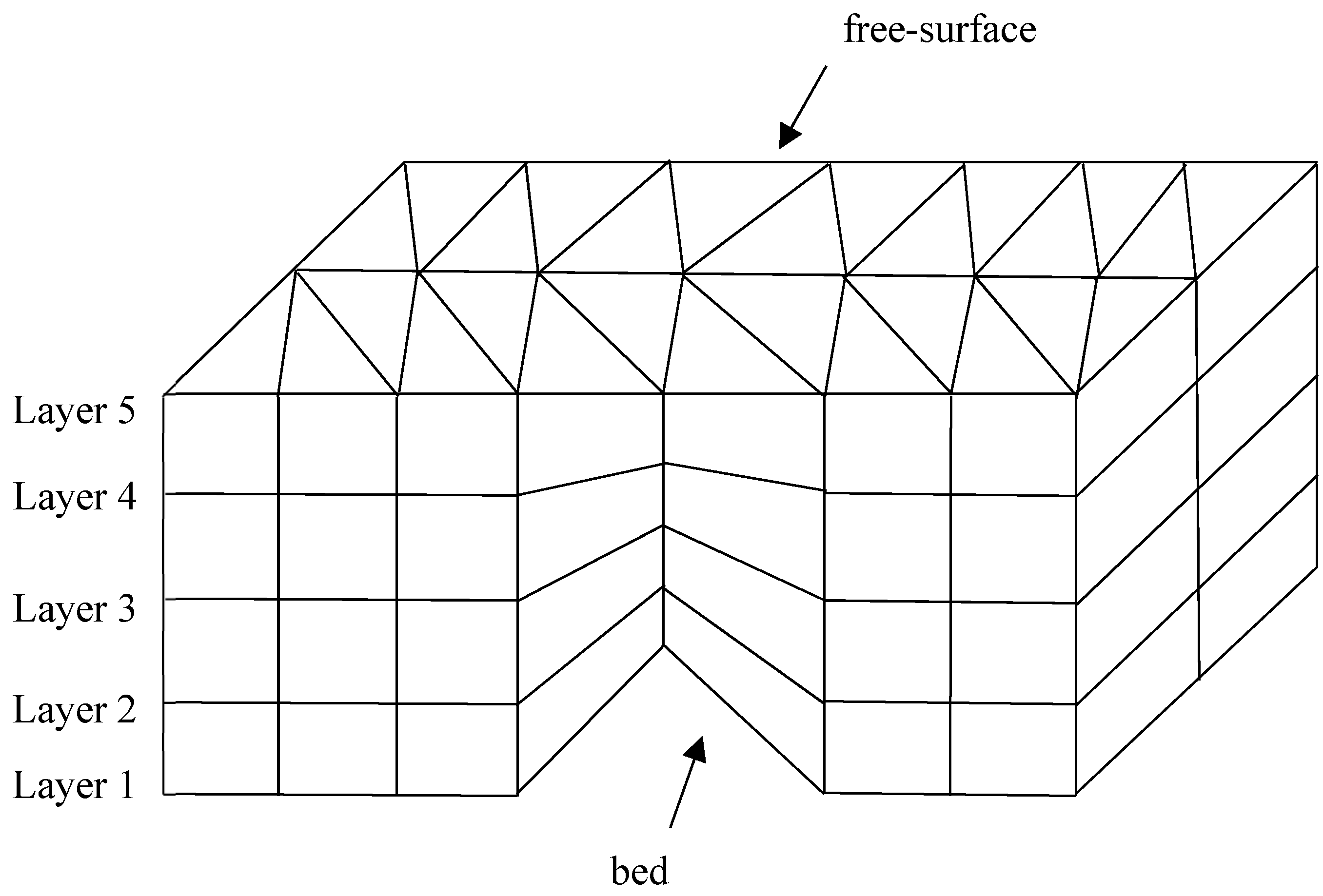
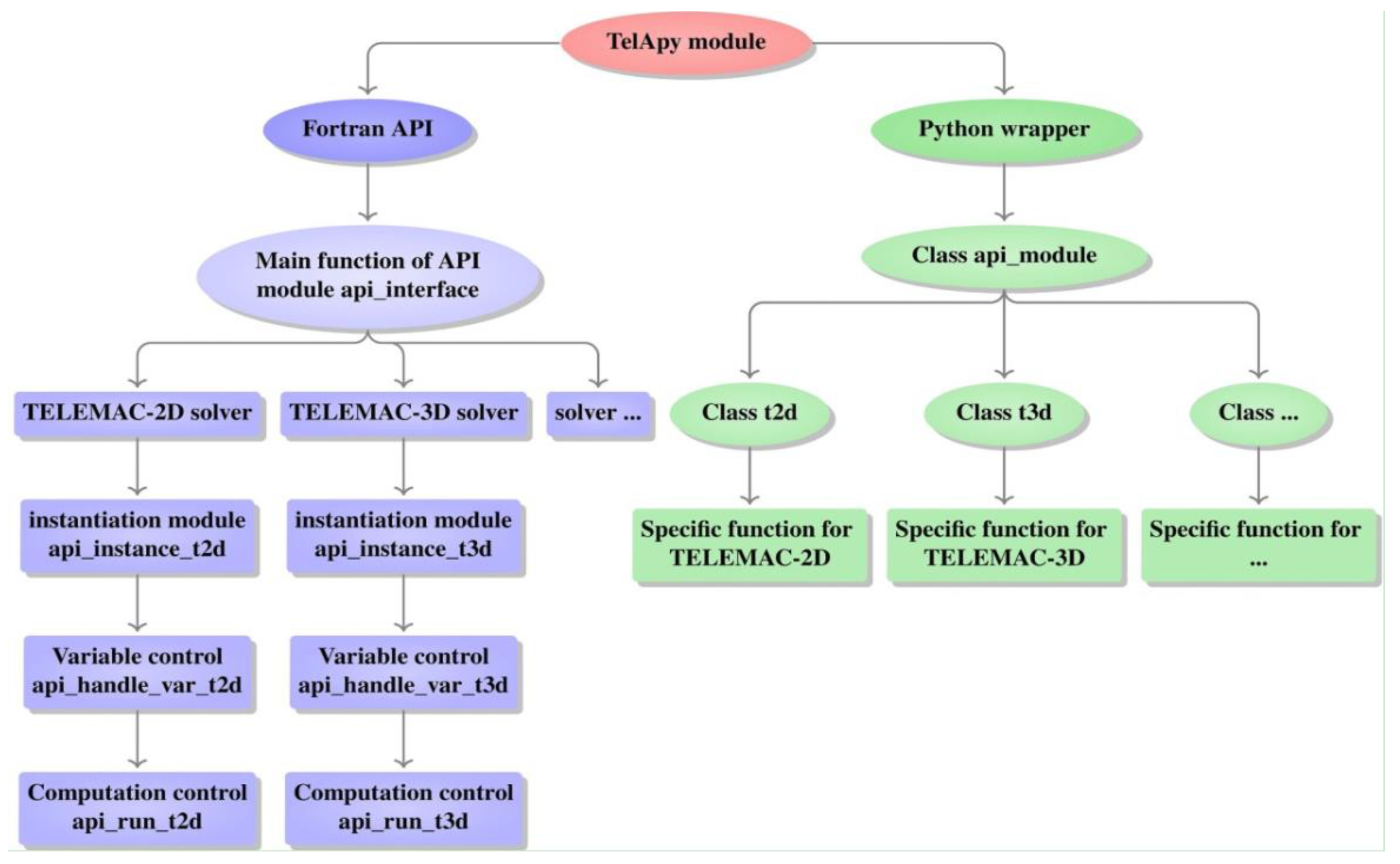

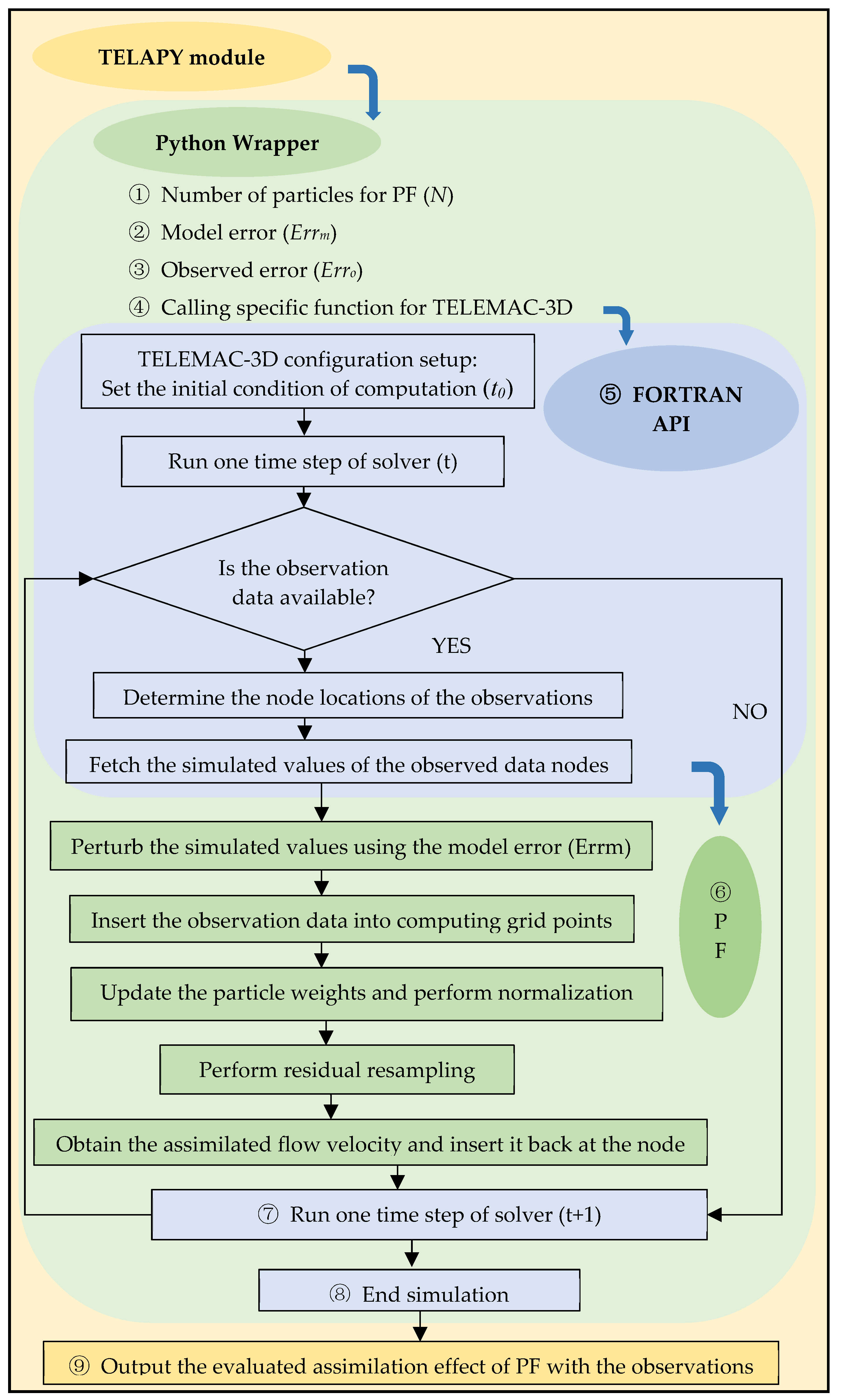
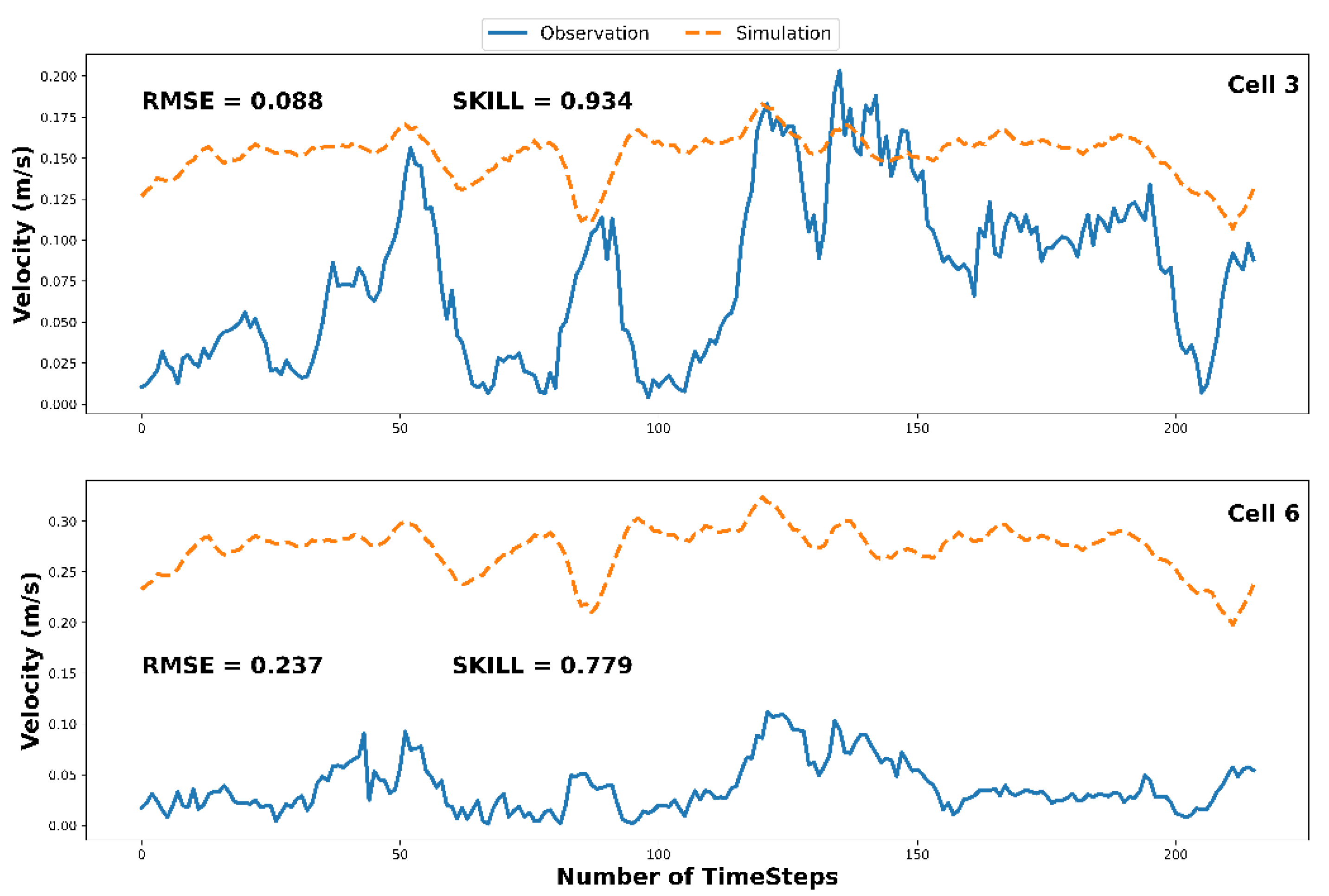


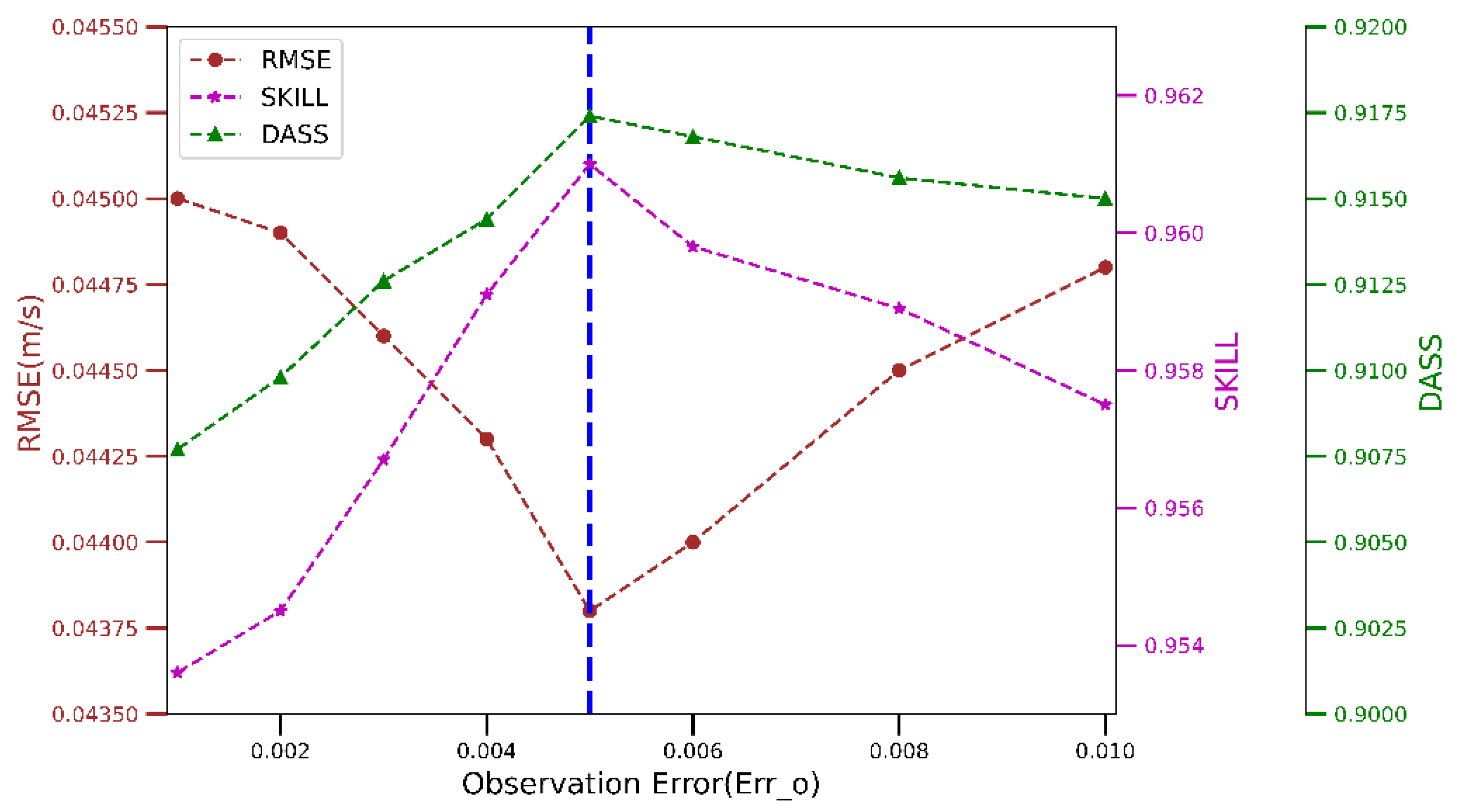
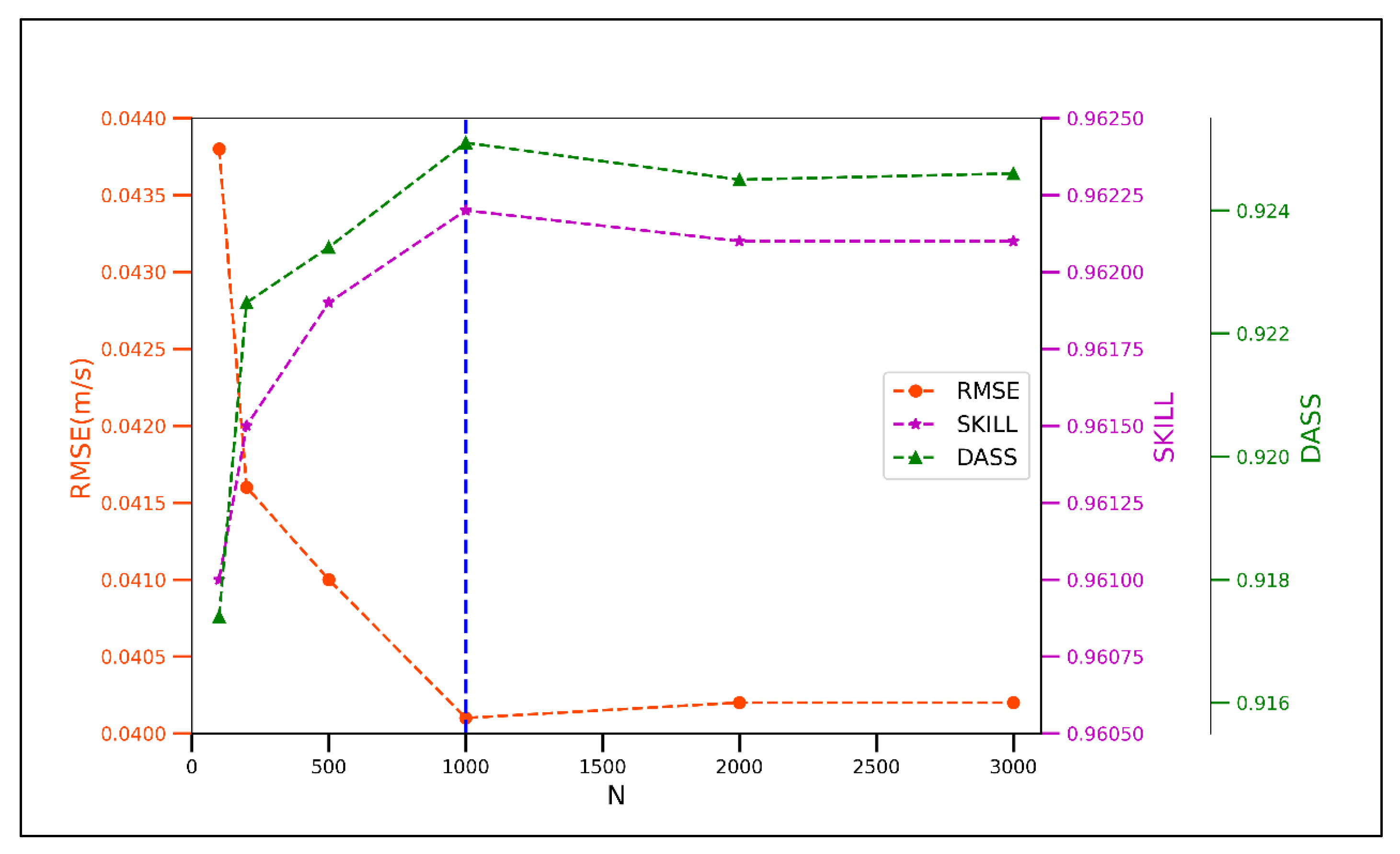

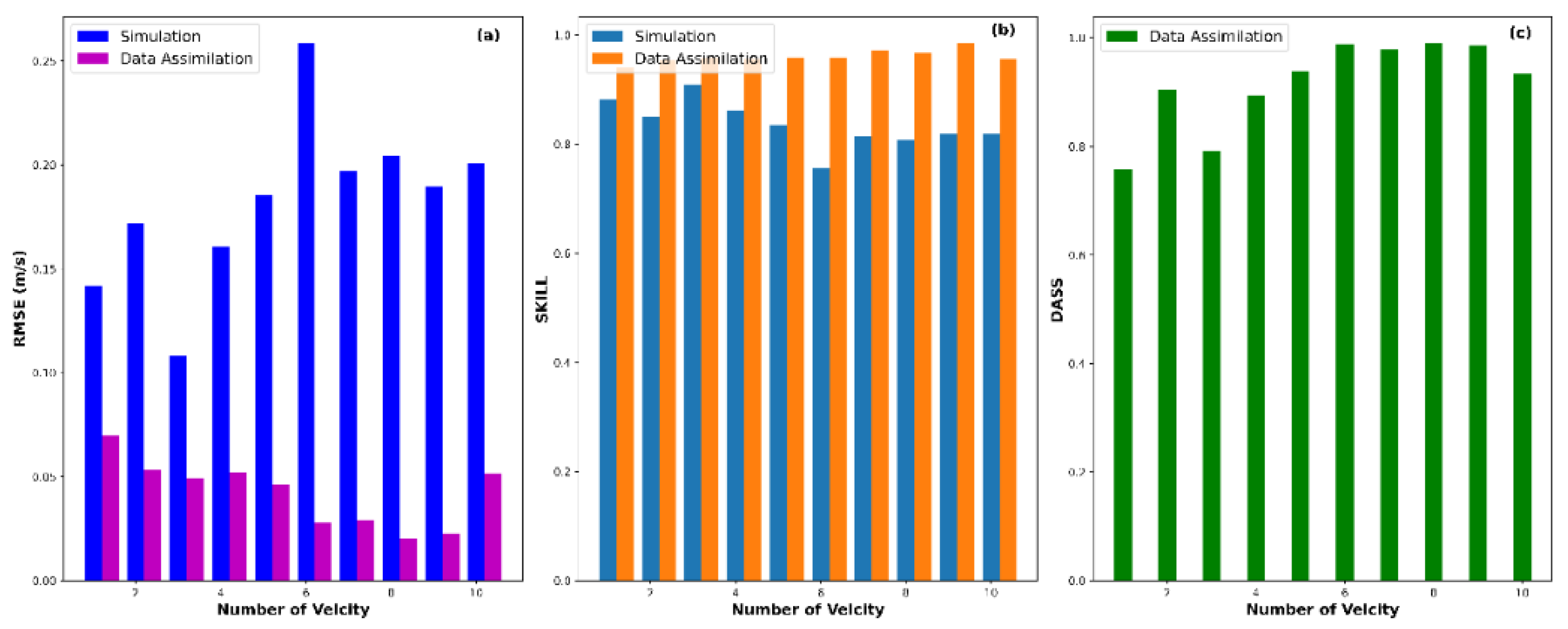
| Method | Operational Complexity | Cost-Effectiveness | Accuracy | Time-Effectiveness | Ecological Impact |
|---|---|---|---|---|---|
| Float method | Easy | Inexpensive | Low | Efficient | Non-polluting |
| Dilution gauging method | Difficult | Inexpensive | Low | Efficient | Affects the stream ecosystem |
| Trajectory method | Difficult | Inexpensive | High | Inefficient | Non-polluting |
| Current meter method | Difficult | Expensive | High | Efficient | Non-polluting |
| Acoustic Doppler’s current profiler method | Difficult | Expensive | High | Efficient | Non-polluting |
| Electromagnetic method | Difficult | Expensive | High | Efficient | Non-polluting |
| Remote sensing method | Difficult | Expensive | Low | Efficient | Non-polluting |
| Particle image velocimetry | Difficult | Expensive | High | Efficient | Non-polluting |
| Trial | Verification Metrics | Number of Cell | ||||||||||
|---|---|---|---|---|---|---|---|---|---|---|---|---|
| 1 | 2 | 3 | 4 | 5 | 6 | 7 | 8 | 9 | 10 | Mean | ||
| Calibration Exercise | RMSE | 0.114 | 0.147 | 0.088 | 0.134 | 0.161 | 0.237 | 0.176 | 0.183 | 0.183 | 0.178 | 0.16 |
| SKILL | 0.915 | 0.884 | 0.934 | 0.894 | 0.865 | 0.779 | 0.84 | 0.831 | 0.824 | 0.85 | 0.86 | |
| Validation Exercise | RMSE | 0.142 | 0.171 | 0.103 | 0.156 | 0.179 | 0.248 | 0.192 | 0.19 | 0.177 | 0.199 | 0.175 |
| SKILL | 0.879 | 0.849 | 0.913 | 0.863 | 0.839 | 0.768 | 0.819 | 0.824 | 0.83 | 0.821 | 0.84 | |
| Trial | Parameters | Verification Metrics | ||||
|---|---|---|---|---|---|---|
| Model Error (m/s) | Observation Error (m/s) | Number of Particles (-) | RMSE (m/s) | SKILL (-) | DASS (-) | |
| 1 | 0.01 | 0.001 | 100 | 0.1862 | 0.9055 | −0.0505 |
| 2 | 0.05 | - | - | 0.1542 | 0.9141 | 0.3023 |
| 3 | 0.08 | - | - | 0.091 | 0.9326 | 0.7523 |
| 4 | 0.1 | - | - | 0.0533 | 0.9471 | 0.8974 |
| 5 | 0.2 | - | - | 0.045 | 0.9536 | 0.9077 |
| 6 | 0.2 | 0.002 | 0.0449 | 0.9545 | 0.9098 | |
| 7 | 0.2 | 0.003 | 0.0446 | 0.9567 | 0.9126 | |
| 8 | 0.2 | 0.004 | 0.0443 | 0.9591 | 0.9144 | |
| 9 | 0.2 | 0.005 | - | 0.0438 | 0.961 | 0.9174 |
| 10 | 0.2 | 0.005 | 200 | 0.0416 | 0.9615 | 0.9225 |
| 11 | 0.2 | 0.005 | 500 | 0.041 | 0.9619 | 0.9234 |
| 12 | 0.2 | 0.005 | 1000 | 0.0401 | 0.9622 | 0.9251 |
| Trial | Verification Metrics | Number of Cell | ||||||||||
|---|---|---|---|---|---|---|---|---|---|---|---|---|
| 1 | 2 | 3 | 4 | 5 | 6 | 7 | 8 | 9 | 10 | Mean | ||
| SIM | RMSE | 0.142 | 0.172 | 0.108 | 0.16 | 0.186 | 0.259 | 0.197 | 0.204 | 0.19 | 0.201 | 0.182 |
| SKILL | 0.882 | 0.849 | 0.91 | 0.861 | 0.836 | 0.756 | 0.815 | 0.808 | 0.819 | 0.819 | 0.836 | |
| DA | RMSE | 0.07 | 0.053 | 0.049 | 0.052 | 0.046 | 0.028 | 0.029 | 0.021 | 0.022 | 0.051 | 0.042 |
| SKILL | 0.94 | 0.954 | 0.959 | 0.956 | 0.958 | 0.958 | 0.971 | 0.968 | 0.985 | 0.957 | 0.96 | |
| DASS | 0.759 | 0.904 | 0.791 | 0.894 | 0.939 | 0.989 | 0.978 | 0.99 | 0.986 | 0.934 | 0.92 | |
Publisher’s Note: MDPI stays neutral with regard to jurisdictional claims in published maps and institutional affiliations. |
© 2022 by the authors. Licensee MDPI, Basel, Switzerland. This article is an open access article distributed under the terms and conditions of the Creative Commons Attribution (CC BY) license (https://creativecommons.org/licenses/by/4.0/).
Share and Cite
Sun, Y.; Zhang, L.; Liu, J.; Lin, J.; Cui, Q. A Data Assimilation Approach to the Modeling of 3D Hydrodynamic Flow Velocity in River Reaches. Water 2022, 14, 3598. https://doi.org/10.3390/w14223598
Sun Y, Zhang L, Liu J, Lin J, Cui Q. A Data Assimilation Approach to the Modeling of 3D Hydrodynamic Flow Velocity in River Reaches. Water. 2022; 14(22):3598. https://doi.org/10.3390/w14223598
Chicago/Turabian StyleSun, Yixiang, Lu Zhang, Jiufu Liu, Jin Lin, and Qingfeng Cui. 2022. "A Data Assimilation Approach to the Modeling of 3D Hydrodynamic Flow Velocity in River Reaches" Water 14, no. 22: 3598. https://doi.org/10.3390/w14223598
APA StyleSun, Y., Zhang, L., Liu, J., Lin, J., & Cui, Q. (2022). A Data Assimilation Approach to the Modeling of 3D Hydrodynamic Flow Velocity in River Reaches. Water, 14(22), 3598. https://doi.org/10.3390/w14223598





